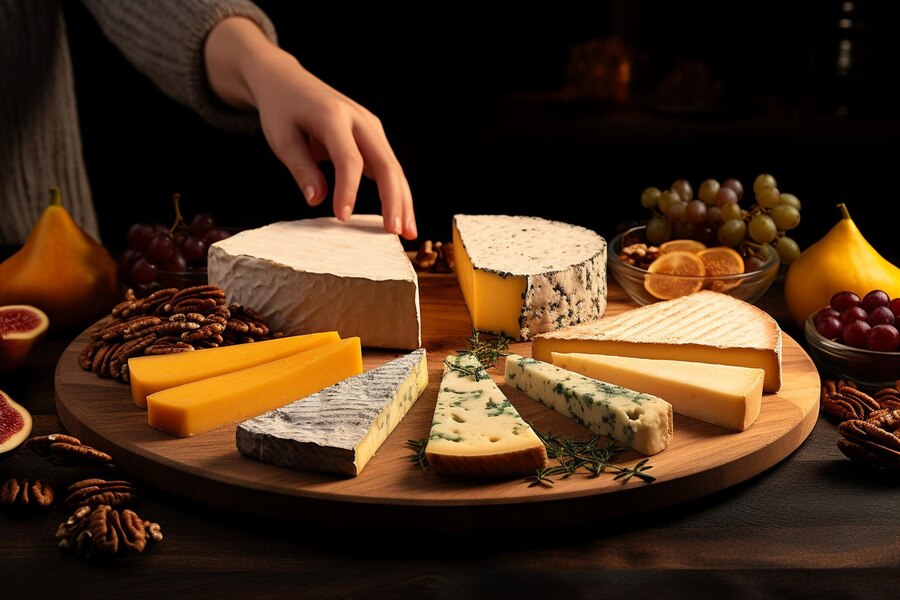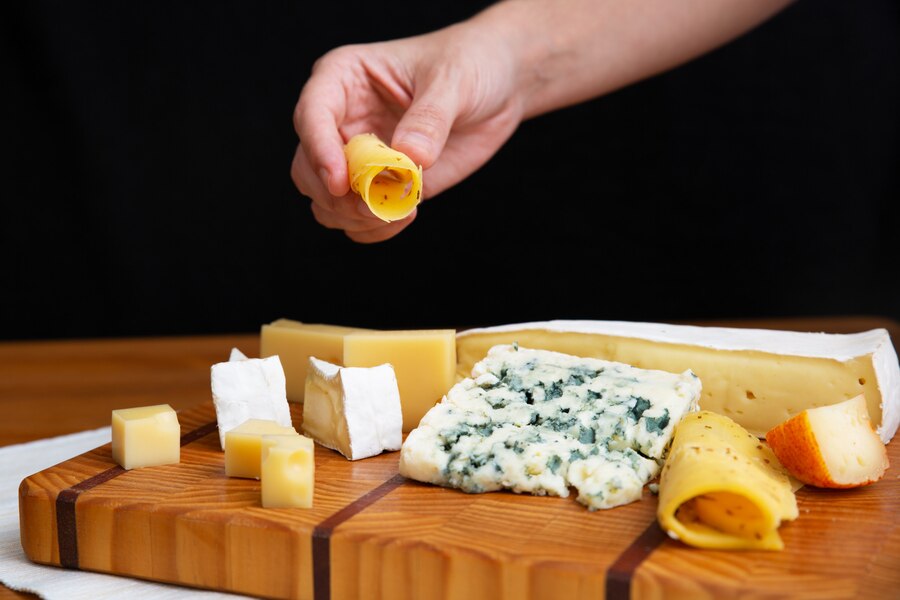Muenster cheese is a semi-soft, creamy cheese known for its smooth texture and mild flavor. Originating from the Alsace region of France and later adapted in the United States, Muenster cheese has become a beloved staple in many households due to its versatility and unique taste.
Brief History of Muenster Cheese
The origins of Muenster cheese can be traced back to the monasteries of Alsace, where monks created this delightful cheese as a way to preserve milk. The American version of Muenster, which is milder and less pungent, evolved when immigrants brought their cheesemaking traditions to the United States in the 19th century.
European vs. American Muenster
European Munster, often referred to as Munster-Géromé, has a stronger, more pungent aroma and taste, reflecting its traditional Alsatian roots. In contrast, American Muenster is milder, with a subtle flavor that appeals to a broader audience. Both versions share a similar appearance with an orange rind and pale interior but differ significantly in taste and texture.
The Cultural Significance of Muenster Cheese
Muenster cheese holds a special place in both European and American culinary traditions. In Europe, it’s a celebrated part of regional cuisine, often enjoyed with hearty bread and robust wines. In the U.S., Muenster has become a versatile ingredient in various dishes, reflecting the melting pot of American culinary practices.
Milk Selection
The journey of Muenster cheese begins with high-quality milk, typically from cows. The choice of milk significantly impacts the flavor and texture of the final product.
Curdling
The first step in making Muenster cheese is curdling the milk, which involves adding rennet to the milk to separate the curds from the whey. This process creates the foundation for the cheese’s texture.
Aging
After curdling, the curds are cut, drained, and pressed into molds. The cheese is then aged for a few weeks to develop its characteristic flavor and texture. The aging process also includes regular washing of the rind, which gives Muenster its distinct orange color.
Unique Characteristics
What sets Muenster cheese apart is its washed rind and the mild yet distinct flavor profile. The rind-washing process imparts a slight tanginess, while the interior remains creamy and smooth.
Taste Description
Muenster cheese is known for its mild, slightly tangy flavor that can develop a sharper taste as it ages. The flavor is often described as buttery with a hint of nuttiness, making it a versatile choice for various dishes.
Texture and Appearance
This cheese boasts a semi-soft texture that melts beautifully, making it ideal for grilled sandwiches and casseroles. The vibrant orange rind contrasts with the pale, creamy interior, adding visual appeal to any cheese platter.
Comparison with Other Cheeses
Compared to cheeses like Cheddar or Swiss, Muenster is milder and less complex in flavor. It shares a similar texture with Havarti but is distinguished by its unique rind and subtle tang.
Macronutrients
Muenster cheese is a good source of protein and fat. A typical serving provides about 6 grams of protein and 9 grams of fat, contributing to a satiating and energy-dense snack or meal component.
Vitamins and Minerals
Rich in calcium and vitamin A, Muenster cheese supports bone health and vision. It also contains notable amounts of vitamin D, which aids in calcium absorption, and phosphorus, essential for cellular function.
Health Benefits
Consuming Muenster cheese in moderation can be part of a balanced diet. The protein content helps in muscle repair and growth, while the calcium supports bone density. However, due to its fat content, it should be enjoyed in appropriate portions.
Melting Properties
One of the standout features of Muenster cheese is its excellent melting quality. It becomes gooey and smooth when heated, making it perfect for dishes like grilled cheese sandwiches, macaroni and cheese, and quesadillas.
Pairing with Other Foods
Muenster cheese pairs wonderfully with a variety of foods. Its mild flavor complements both sweet and savory ingredients, from apples and pears to ham and turkey. It also enhances the taste of burgers and sandwiches.
Popular Recipes
Grilled Muenster Cheese Sandwich: A classic comfort food, enhanced by the cheese’s melting properties.
Muenster Mac and Cheese: A creamy, decadent twist on traditional mac and cheese.
Cheese Platters: Muenster adds a unique flavor and texture to any cheese board, paired with fruits, nuts, and crackers.
How to Choose Quality Muenster Cheese
When buying Muenster cheese, look for a vibrant orange rind and a creamy interior. Avoid cheese with an overly strong ammonia smell, as this indicates it may be past its prime.
Storage Tips to Maintain Freshness
To keep Muenster cheese fresh, wrap it in wax paper or parchment paper and store it in the refrigerator. Avoid plastic wrap, which can trap moisture and affect the cheese’s texture. For longer storage, Muenster cheese can be frozen, but this may alter its texture slightly.
References in Media
Muenster cheese occasionally appears in popular culture, often in cooking shows and food blogs where its versatility and melting properties are showcased. It’s also a favorite subject in cheese-themed events and festivals.
Muenster Cheese in Restaurants
Many restaurants feature Muenster cheese in their dishes, particularly in gourmet grilled cheese sandwiches, burgers, and specialty salads. Its unique flavor and melting ability make it a popular choice among chefs.
Differentiating from Similar Cheeses
Muenster is often confused with cheeses like Havarti or Monterey Jack due to its mild flavor and semi-soft texture. However, its distinct orange rind and slight tang set it apart.
Myths and Facts
One common myth is that Muenster cheese is only good for melting. While it’s true that Muenster melts beautifully, it also shines in cold dishes and cheese platters, offering a mild yet flavorful addition to any meal.
Muenster Cheese for Vegetarians
Traditional Muenster cheese uses animal rennet, but there are vegetarian versions available made with microbial rennet. Always check the label to ensure it meets dietary preferences.
Lactose Intolerance Considerations
Muenster cheese is relatively low in lactose, making it easier to digest for those with lactose intolerance. However, individual tolerance levels vary, so it’s best to consume in moderation.
Basic Recipe for Homemade Muenster
Making Muenster cheese at home requires milk, rennet, and a few weeks of patience. Start by curdling the milk with rennet, then press the curds into molds and allow them to age, washing the rind regularly to develop its characteristic color and flavor.
Tips for Home Cheesemakers
Use high-quality milk for the best results.
Ensure a consistent aging environment to avoid spoilage.
Patience is key; aging time is crucial for developing the right texture and flavor.
American Muenster
American Muenster is typically milder and has a smoother texture compared to its European counterpart. It’s popular for its melting properties and is commonly used in sandwiches and snacks.
French Munster
French Munster, also known as Munster-Géromé, is stronger in flavor and aroma, often enjoyed with hearty Alsatian dishes. It has a more robust, tangy taste and a firmer texture.
Best Wine Pairings
Muenster cheese pairs well with both white and red wines. Try it with a crisp Riesling or a fruity Pinot Noir to complement its mild flavor.
Beer and Other Beverages
For beer lovers, a light lager or pilsner pairs beautifully with Muenster cheese. The carbonation and mild flavors of these beers balance the cheese’s creamy texture and subtle tang.
Fun Trivia
Muenster cheese is often used in fondue recipes for its excellent melting properties.
The orange rind is achieved through regular washing with a brine solution, sometimes tinted with annatto for color.
Historical Anecdotes

Muenster cheese has its roots in monastic traditions, where monks perfected the art of cheesemaking as a means of preservation.
The name “Muenster” is derived from the Latin word “monasterium,” reflecting its monastic origins.
Conclusion
Muenster cheese is a versatile and delicious addition to any cheese lover’s repertoire. Whether you enjoy it melted on a sandwich, as part of a cheese platter, or in a gourmet recipe, its mild flavor and creamy texture are sure to delight. With a rich history and diverse culinary applications, Muenster cheese is truly a gem in the world of cheeses.
FAQs
What is the difference between Muenster and Munster cheese?
Muenster refers to the American version, which is milder, while Munster (or Munster-Géromé) is the French version, known for its stronger, more pungent flavor.
How long does Muenster cheese last?
When stored properly in the refrigerator, Muenster cheese can last up to three weeks. Freezing can extend its shelf life but may alter the texture.
Can you freeze Muenster cheese?
Yes, you can freeze Muenster cheese, though it’s best used in cooked dishes after freezing, as the texture may change.
Is Muenster cheese suitable for vegetarians?
Some Muenster cheese is made with microbial rennet, making it suitable for vegetarians. Always check the label to be sure.
What are some popular dishes that use Muenster cheese?
Popular dishes include grilled cheese sandwiches, mac and cheese, cheeseburgers, and quesadillas, all of which benefit from Muenster’s excellent melting properties.
